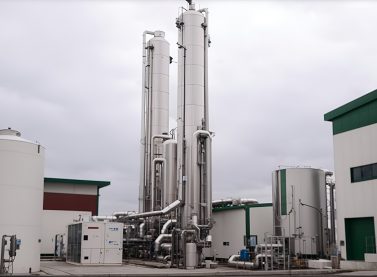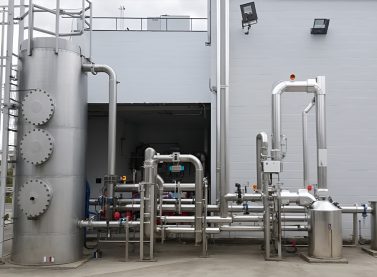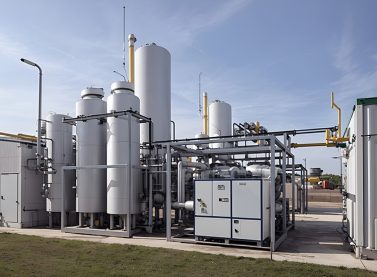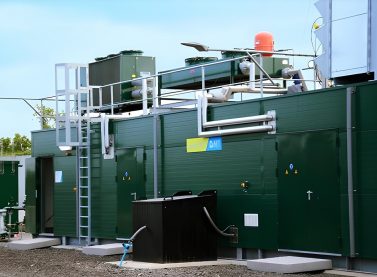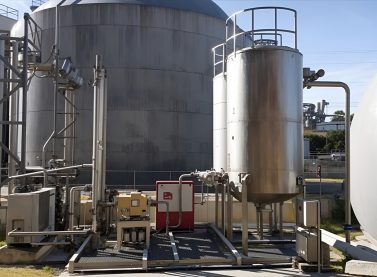Our solutions for biogas cleaning
Condorchem Envitech supplies complete solutions for biogas cleaning for all types of biogas plants regardless of their origin (landfills, WWTP or digestion plants). These solutions include engineering, manufacturing and supply of equipment and technologies, as well as the start-up and mainteinance of the plant.
The CLEAN-BGAS® MP DRY module is designed to reduce the unwanted components of biogas. This module focuses on refrigerating and passing the biogas through activated carbon. Our biogas cleaning plants are delivered fully assembled on a skid so that they are easy to install, operate and maintain.
Characteristics of our biogas cleaning plants:
- Energy and Reagent Optimization: Plants are designed for minimal energy and reagent consumption.
- Automatic Operation: Systems are equipped for automatic operation.
- Comprehensive Cleaning: Simultaneously reduces moisture, hydrocarbons, siloxanes, and partially H2S and NH3 as per customer requirements.
- Compact Design: Compact systems save space and simplify maintenance.
- Moisture Reduction: Reduces both relative and absolute humidity of biogas.
Our equipment
Biogas in cogeneration plants
Biogas can not be used in cogeneration plants without being previously cleaned. This is why the percentage of humidity and all the compounds that can shorten the life of any equipment that uses biogas as fuel must be lowered.
One of the fundamental parts of a biogas plant destined to the use of biogas as biofuel is the collection and cleaning plant. This collection and cleaning plant involves a set of equipment and technologies that are necessary for proper planning and use of biogas.
Components of a Biogas Cleaning Installation:
- Dehumidification/Drying of Biogas: Removing moisture through condensate pots, heat exchangers, and refrigeration machines.
- Cleaning Systems: Utilizing technologies such as activated carbon filters, membranes, and chemical scrubbers to eliminate unwanted components like H2S, siloxanes, hydrocarbons, etc.
These plants involve parts such as:
- System of pipes and equipment (condensate pot, foam separators, particle filters, gravel filters, etc.).
- Transport system. Centrifugal blowers, side channel and rotary. Auxiliaries such as flame arresters, expansion joints and valves.
- Biogas management system. Torch, gasometers and auxiliaries.
CLEAN-BGAS® MP DRY. Biogas cleaning system
A process based on cooling, condensation, washing with water and absorption of activated carbon.
Biogas is a mixture of gases composed mainly of CH4, C02, water vapor and traces of other compounds (H2S, siloxanes, NH3 and hydrocarbons, among others). In order to be able to use it in a CHP system, it is necessary to reduce its moisture content and eliminate all harmful compounds to guarantee the durability of the equipment involved in its use as a biofuel.
The CLEAN-BGAS® MP DRY module guarantees the reduction of these components (water vapor, particles, H2S and siloxanes). The technology has two parts: the refrigeration of biogas and the adsorption of activated carbon. The activated carbon is selected for the main hazardous component. All the equipment is located inside a base to facilitate its operation, maintenance and installation.
Advantages
- Production of high quality biogas
- Reduce energy consumption by 30%
- Long-term adsorbent
- Low maintenance cost
- Fully automated
- Improves exhaust gas emissions from cogeneration systems
Applications
- Elimination of siloxanes and hydrocarbons
- Removal of water vapor
- Elimination of H2S and NH3
- Temperature reduction
- Landfill gas
- Wastewater gas
Technical features
- Modular system
- Suitable for all types of biogas
- Continuous operation since installation
- Simultaneous reduction of temperature, water vapor, H2S, NH3, halogenated hydrocarbons and siloxanes
- Works on vacuum or pressure lines
- Incorporates a separation system for particles and foam
- Complete automation
- Activated carbon filters are easy to handle
- Offers high quality biogas
- May include an energy recovery or reheat system
The need for biogas cleaning and conditioning
Biogas is obtained through the anaerobic decomposition (putrefaction) of organic matter. It contains methane (CH4) in varying proportions, ranging from 35% to 70%, a proportion which largely depends on production methods and the materials involved in the process. This methane concentration is what enables biogas to be used as fuel. The release of methane into the atmosphere contributes to an increase in the greenhouse effect and its capacity to pollute is 21 times greater than that of CO2.
The use of biogas as a fuel or raw material for the production of other goods is the best option, not only because it avoids emissions of methane gas to the atmosphere but also because it reduces emissions of other greenhouse gases that would occur as a result of the combustion of fossil fuels. Biogas is an inexhaustible source of clean, renewable energy, the use of which can be automatically managed. It is one of the most accessible renewable energies, due to the ease with which it can be obtained. Moreover, biogas causes less air pollution and constitutes a viable alternative to the depletion of fossil fuels, such as natural gas and oil, the price of which has been increasing in recent years.
With a net calorific value (NCV) of between approximately 4,000 and 6,000 Kcal/m3, biogas can be used for the production and sale of electricity and heat. It can also be used as a biofuel for vehicles, fed into the natural gas network or used as a raw material for the production of H2 and methanol. However, the most effective use of biogas lies in cogeneration, through which electricity and heat energy is obtained at the same time.
These are the main reasons why an efficient biogas cleaning system is required:
- Optimal Operation of Machinery: Ensures efficient functioning of machinery (engines, turbines, boilers, fuel cells, vehicles, etc.) using biogas as fuel.
- Extended Equipment Lifespan: Prolongs the lifespan of equipment used for pumping, extraction, and compression (blowers and compressors).
- Improved Emissions: Enhances exhaust gas emissions from engine-driven machinery.
- Operator Safety: Prevents toxic concentrations harmful to human operators.
- Reduced Maintenance Costs: Lowers maintenance costs, including oil repairs and replacements, for machinery involved in such installations.
- Efficient Gas Capture, Pumping, Storage, and Distribution System: Ensures optimal operation of the biogas capture, pumping, storage, and distribution system.
Table 1 shows the typical composition of biogas in accordance with its origin, i.e., landfill or methanisation plant, and the type of material to be treated.
| Gases | Agricultural Waste (%) | WWTP Sludge (%) | Industrial Waste (%) | MSW Landfills (%) | Effect |
|---|---|---|---|---|---|
| Methane | 50-80 | 50-80 | 50-70 | 45-65 | Combustible |
| CO2 | 30-50 | 20-50 | 30-50 | 34-55 | Inert |
| Vap H2O | Saturation | Saturation | Saturation | Saturation | Harmful |
| H2 | 0-2 | 0-5 | 0-2 | 0-1 | Combustible |
| H2S | 100-7000 ppm | 0-1 | 0-8 | 0,5-3000 ppm | Corrosive |
| NH3 | 50-100 mg/m2 | Trace | Trace | Trace | Corrosive |
| CO | 0-1 | 0-1 | 0-1 | Trace | Combustible |
| N2 | 0-1 | 0-3 | 0-1 | 0-20 | Inert |
| O2 | 0-1 | 0-1 | 0-1 | 0-5 | Corrosive |
| Siloxanes | NR | 0-100 mg/m2 | NR | 0-50 mg/m2 | Abrasive |
| HCH | NR | Trace | NR | 10-4000 mg/m2 | Harmful |
Table 1
Although all types of biogas are suitable for the production of biomethane, those from controlled processes provide better quality for conversion into a gas with similar characteristics to NG. This is due to the higher methane (CH4) concentration that can be achieved and the lower concentration of pollutants, including O2.
For the application or use of biogas as a combustible material or a raw material for the manufacture of chemical products, such as methanol and hydrogen, its quality must be improved. In order to achieve this, all the harmful components described below must be removed.
Unwanted components in biogas
Water vapour
Water vapour drastically reduces biogas NCV and so affects the energy efficiency of equipment involved in its use as a biofuel (engines, turbines, boilers, burners, etc.). Therefore, prior to use as a biofuel, its moisture content should be reduced as much as possible. The removal of this moisture is also necessary to prevent the accumulation of condensates in the gas line and, in consequence, to prevent the formation of corrosive acids and clogging of pipes.
Heavy and halogenated hydrocarbons
Halogenated hydrocarbons, basically those with chlorine and fluoride, can cause corrosion of generator engines, especially in the combustion chamber, valves and cylinder heads. Hydrocarbons with a high molecular weight can cause malfunctioning of the engine, due to the fact that the ignition point differs greatly from the ignition point of biogas (CH4). In many cases, these hydrocarbons combust partially, causing an increase in the concentration of formaldehyde, VOCs and other components in the flue gases of this type of equipment.
Hydrogen sulphide (H2S)
Desulphurisation of biogas is necessary to prevent corrosion and toxic concentrations of hydrogen sulphide (H2S). When biogas is burned, sulphur oxides, such as SO2/SO3 are formed and these are even more toxic than the H2S from which they originate. At the same time, SO2 lowers the condensation point of the flue gas (fumes), with the possible formation of sulphurous acid (H2SO3), which is highly corrosive. Moreover, when hydrogen sulphide (H2S) mixes with the humidity in the air (water) or the humidity of the biogas itself in the combustion chamber or boilers, sulphuric acid (H2SO4) is formed and this attacks metal components, particularly those containing copper (Cu), bronze, iron or other materials, thereby considerably reducing the performance of these components. In addition, in the case of engines, it contaminates the lubricant, producing environmentally damaging sulphur oxide emissions in the flue gases.
Siloxanes
Siloxanes are amongst the most common components in biogas generated in landfills and/or treatment plants for energy purposes. They damage engines and reduce engine life due to the abrasive effect they exercise on the internal components. This effect is due to the silica deposited on the different engine parts as a result of the combustion that takes place in the internal part of the engine.
Technologies for the separation/removal of harmful biogas components
Many separation/removal technologies are applied to reduce these types of components. Each is aimed at a particular component, in accordance with the origin of the biogas and its potential application. In the final part of this article, I will describe the Biolimp-Siloxa combined technology for siloxane removal.
The Biolimp-Siloxa technology for biogas conditioning/cleaning features a set of interconnected equipment which enables the removal by physical means (heat and adsorption) of moisture, siloxanes, halogenated compounds and H2S. It also enables the temperature of the gas to be reduced to permissible values for use in engines.
The module carries out different operations in a pre-established order (multi-function technology): cooling (temperature reduction), condensation (removal of moisture, siloxanes, hydrogen sulphide) and adsorption (reduction of undesirable components, such as siloxanes, H2S and hydrocarbons). For this purpose, the module features a number of different internal elements.
Technical basis
Cooling of the biogas is carried out to bring its temperature to 2 ºC for the removal of siloxanes. Condensation is carried out to reduce biogas moisture levels. Scrubbing takes place for the reduction of acidic gases (H2S) and ammonia (NH3), and adsorption with activated carbon takes place for the removal of siloxanes and halogenated compounds.
Technology stages
This technology consists of the following stages: preliminary cooling to 20 ºC for the reduction of absolute humidity; scrubbing of the gas and extraction of condensates; cooling to 2-4 ºC to reduce siloxane and absolute humidity levels; heating of the gas and reduction of relative humidity, and finally, adsorption with activated carbon. Figure 1 shows Biolimp-Siloxa technology constructed in 2008 for the Arico landfill in Tenerife (Canary Islands), owned by Grupo Urbaser. It is made up of a recovery-cleaning unit, a dehumidifier, a condensate collection tank and activated carbon filters.
Table 2 shows operating results of the Biolimp-Siloxa technology. The Biolimp-Siloxa module/ technology is the result of five years of R&D&i carried out by Energy & Waste SLNE, a company with over 15 years of experience in the treatment of biogas generated in landfills, methanisation plants, wastewater treatment plants and gas treatment plants. The company is currently continuing its research work with a view to achieving increased energy efficiency and enhanced contaminant removal performance.
| Flow | 3,000 Nm3/h | |||
|---|---|---|---|---|
| Temperature inlet | 50°C | |||
| Pressure Inlet | - 200 mbar | |||
| Components | Inlet (mg/Nm3) | Outlet (mg/Nm3) | Removal (%) | Energy saving (%) |
| Siloxanes | 38 | < 1 | > 97,3 | 21 |
| H2S | 120 | < 1 | > 99,2 | |
| BTEX | 750 | < 5 | > 99,5 | |
| Hydrocarbons | 3957 | < 20 | > 99,5 | |
| Weight CA | 100,000 Kg | |||
| No Filters | 2 | |||
| Lifespan | 2 months | |||
| Cost CA | 1,9/kg | |||
Table 2
